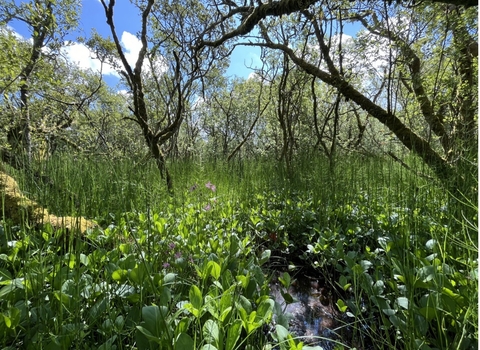Fen carrs are naturally wooded, waterlogged peatlands fed by mineral-rich groundwater and surface water (minerotrophic). Fen carrs often occur in mosaic with other habitats, particularly drier woodlands and fens, and the boundaries between these habitats can be sharp or gradual, often changing over time in response to changes in hydrological conditions.
The rich vegetation of fenn carrs is made up of the dominant tree species, such as willow (Salix spp.), alder (Alnus spp.) and birch (Betula spp.) and a herbaceous understory. These habitats can appear dense and tangled, with a shaded understory consisting of rich vegetation of shrubs such as guelder rose (Viburnum opulus), buckthorn (Rhamnus spp.), dog rose (Rosa canina) and brambles (Rubus spp.), as well as ferns, sedges, mosses and liverworts interspersed with pools of standing water.
The flora and fauna of fen carrs can be quite different to that of open fens. Royal fern (Osmunda regalis), yellow flag iris (Iris pseudacorus), Angelica, marsh hawk’s-beard (Crepis paludosa) and meadowsweet (Filipendula ulmaria) are common, and rarer species such as coral-root orchid (Corallorhiza trifida) can sometimes be found in the north. Carrs support a rich invertebrate community, including the netted carpet moth (Eustroma reticulatum) and cranefly Prionocera subserricornis. Herons, willow tits (Poecile Montanus) and lesser redpolls (Carduelis Cabaret) also inhabit carrs.

Dog rose. Credit Pavel Kacl; licenced under CC BY-NC 4.0 (https://creativecommons.org/licenses/by-nc/4.0/).
Meadowsweet. Credit Nina Filippova; licenced under CC BY NC 4.0 (https://creativecommons.org/licenses/by-nc/4.0/).

Royal fern. Credit isaflo; licenced under CC BY NC 4.0 (https://creativecommons.org/licenses/by-nc/4.0/).

Netted carpet moth. Credit Pavlozaltowski; licenced under CC BY-NC 4.0 (https://creativecommons.org/licenses/by-nc/4.0/)

Crenefly Prionocera subserricornis. Credit Vladimir Bryukhov; licenced under CC BY-NC 4.0 (https://creativecommons.org/licenses/by-nc/4.0/)

Lesser redpoll. Credit Dave; licenced under CC BY-NC 4.0 (https://creativecommons.org/licenses/by-nc/4.0/)
Fen carrs have significant capacity for carbon sequestration, both in the form of peat and in the biomass of trees. Consequently, wet woodlands hold considerable potential to contribute to net zero climate strategies while offering additional ecosystem services, such as flood regulation and water quality enhancement. Despite these benefits, the ecological and carbon cycling processes of wet woodlands, along with their biodiversity value, remain under-researched and underappreciated.
*We thank the Wet Woodland Research Network for their valuable input.





